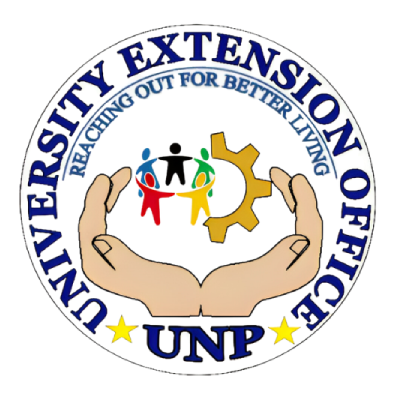
About Us
The University Extension Office (UEO) spearheads the conduct of extension activities along the University’s agenda geared to-wards the quest for new knowledge.

The University Extension Office (UEO) spearheads the conduct of extension activities along the University’s agenda geared to-wards the quest for new knowledge.
The UNP Research Agenda 2023- 2028 will provide the concrete direction of the University in terms of research and development for the next five (5) years.
It represents and addresses the interests of the global, national, as well as regional needs and priority areas, and the development thrusts of the University. It will be based on the following agenda/ goals/ thrusts:
The United Nation’s seventeen (17) Sustainable Development Goals, 2023 Gender Social Norms Index, Ambisyon Natin 2040, the 8 Point Agenda of Pres. Ferdinand R. Marcos Jr. which is the basis of the Philippine development Plan (2023-2028) the DOST’s Harmonized National Research and Development Agenda 2022-2028 (HNRDA), the NEDA’s Ambisyon Natin 2040, the CHED’s National Higher Education Research Agenda-2 (NHERA), the Department of Health’s Regional Unified Health Research Agenda (RUHRA) and the National Unified Health Research Agenda (NUHRA), The National Commission for Culture and the Arts 12 Point Research Agenda, the Department of Social Welfare Development Research and Evaluation Agenda, Bagong Pilipinas Campaign ( Philippine Administrations brand of Governance & and Leadership), and the UNPs 12 Point Agenda and the 2018- 2022 UNP Research Agenda.
1. Program/curricular studies on higher education
2. Policy oriented studies
3. Quality and Standards in the context of:
4. Technology and education (Technological Pedagogical Content Knowledge (TPACK)Framework
5. Universal Primary Education
6. Manpower demand and supply studies
7. Graduate tracer and impact studies
8. Performance in Board Examinations
9. Other topics considered by the CHED in response to the emerging needs of the country
AREA: Social sciences
Data Collection and Analysis of Social Phenomena
2. Documentation of Indigenous Knowledge
3. National Security and Sovereignty
4. Arts, History and Culture
#Cultural and Natural Heritage
5. Extant cultural heritage of ethnolinguistic groups
6. Gender and feminist researches
7. Inclusive Nation- Building
1. Priority Diseases
a. Communicable diseases
b. Non-communicable diseases
2. Diagnostic test done at the time and place of patient care
a. Screening / confirmatory / prognostic
3. Drug discovery and development
a. Infectious diseases
b. Non-communicable diseases
4. Hospital Equipment and Biomedical Devices
5. Disease management
6. Sexual and Reproductive Health
7. Mental health
8. Maternal Newborn and Child health
9. Health technology and Innovation
10. Health Promotion
11. Health of Vulnerable Populations
12. Health security, emergency and disaster and risk management
13. Health Systems strengthening towards UHC
14. Risk reduction and Climate Change
15. Mental Health and Substance Abuse
16. Health Governance and Policies
17. Tuklas Lunas (Drug Discovery and development)
18. Diagnostics
19. Functional Foods
20. OMIC Technology for health
21. Biomedical Devices Engineering for health
22. Digital and frontier health technologies
23. Disaster Risk Reduction/ Climate Change Adaptation in Health
24. Intellectual property and technology management program
25. Capacity Building Programs
26. Network Institution Development
27. Functional Foods
a. Priority Foods
b. Specific topics
28. Nutrition and food quality and safety
a. Food fortification
b. Development/revision of nutrition tools and standards
c. Nutritional assessment and monitoring
d. Nutrition surveys
e. Enhancement of food composition database for dietary exposure assessment
a. Exposure assessment of selected nutrients, food contaminants, and food additives in commonly consumed foods
b. Food and Nutrition Security ( taxonomic study of flora and fauna as food sources; food safety of raw and processed foods of MSMEs; Halal Studies)
c. Health Sufficiency
1. Crops R&D
a. Germplasm evaluation, conservation, utilization and management
2. Varietal improvement and selection
3. Production of good quality seeds and planting materials
a. Development/ optimization of seed production protocols
b. Establishment of sustainable seed system
4. Cultural Management Practices
a. Soil health, nutrient and water management
b. Development of biofertilizers and soil fertility enhancers
c. Development of eco-friendly pest and disease management and control strategies
d. Organic Agriculture
5. Crop production systems research
a. Smart farming approaches
b. Off-season production and cultivation
c. Development of climate-resilient technologies
d. Urban farming
e. Intercropping and integrated farming systems
6. Postharvest, processing and product development
7. Decision Support systems
Priority Commodities Agriculture (Crops)
8. Aquatic R&D
a. New cultivable species for culture
b. Development/ Refinement of culture systems (broodstock management, hatchery, nursery, grow-out)
c. Fish health, disease diagnostics and disease management
d. Nutrition, feeds and feeding systems
e. Postharvest handling, processing and new product development
f. Mechanization and automated systems for feeding, water and culture management and post production
g. Fishkill warning and mitigation systems and environmental management for sustainable aquaculture
h. Management of fisheries
i. Roll out/ Commercialization of aquatic technologies
Priority Commodities
9. Forestry R&D
a. Development and sustainable management practices
b. Development of high yielding varieties (HYVs) of priority timber species with superior traits
c. Development of sustainable harvesting and postharvest techniques/technologies and marketing strategies for timber and non-timber forest species/products
d. Innovative product development
e. Physiological and ecological studies
10. Natural Resources and Environment R&D
a. Sustainable utilization, conservation and management of biodiversity in terrestrial, forestry and marine ecosystems
b. Sustainable watershed management and utilization
c. Management and rehabilitation of problem, degraded and polluted agricultural soils through remediation
d. Development of high value products from agricultural and forest wastes
e. Strategies/decision management tools for climate change resilient environment
f. Resource and ecosystems assessment and monitoring
g. Habitat management for fishery and ecosystem sustainability
h. Marine environmental management (to include Harmful Algal Blooms, coastal integrity/erosion, fish kills and eutrophication)
i. Ecotourism Management
j. Innovative management systems for unique landscapes and ecosystems
k. Reef assessment, monitoring and conservation
l. Control and management of risks and hazards in water ecosystems
m. Water Security
> watershed studies
> water quality, accessibility and availability
n. Assessment of natural resource carrying capacity/ ecological limits
o. Natural capital accounting
Priority Commodities (Natural resources & Environment)
a. Bamboo
b. Rattan
c. sago
d. Tiger grass
e. Vines and non- timber
f. Biodiversity
– Ecosystem (e.g. mangrove, marine freshwater)
– Microbial
– Flora and Fauna
– Ecotourism
g. Climate change adaptation and disaster risk reduction
11. Climate Change Adaptation and Disaster Risk Reduction
a. Mitigation and adaptation studies of vulnerable communities and ecosystems (including protected agriculture, vertical agriculture)
b. Development of smart farming approaches (including organic agriculture, integrated farming, ICT application) and other climate-resilient agricultural production technologies
c. Development of strategies/decision management tools for climate change resilient environment (e.g. farm diversification)
d. Enhancing sustainable development through lifescape-landscape approach
12. Technology Transfer
a. Development of innovative and improvement of traditional extension modalities for the efficient transfer of technologies to end-users
b. Upscaling of agricultural technology transfer and commercialization
c. Leveraging technologies for building resilience and supporting economic recovery
13. Socio-Economics, Policy Research and Governance
a. Continuing review of existing policies affecting the AANR sectors
b. Policy research and advocacy on natural resources/environment-related issues, agricultural trade, supply chain/value chain related issues, standards and regulations, compliance to standards across the value chain and R&D governance, and other cross- cutting policy
c. Impact assessment of technologies, AANR programs and projects
d. Socio-economic studies on production and marketing efficiencies, role of social institutions in technology adoption, labor migration, development of social enterprise models, gender and development
e. Agriculture and resource economic studies including market research, agrarian/asset reform, environmental valuation, economies of scale/collective farming
f. Policy studies on global competitiveness of Philippines AANR sector
g. Integrating gender and development (GAD) in AANR programs and projects
h. Software technologies towards better foresight and strategic insights
i. Applied rural sociology studies covering but not limited to characterization and understanding rural communities; demographic and intergenerational changes of AANR stakeholders (e.g. farmers, fishers, Ips); social practices and behavior and their implications to technology adoption; role social institutions and institutional arrangements
j. Supply value/ value chain development of selected AANR industries and other agribusiness related activities
k. Impact assessment of mature technologies, AANR programs and projects
l. Human Capital Systems ( Human Development, Science Communication and Knowledge Management)
m. Efficient and impactful AANR human development programs
n. Public engagement and communicating AANR R&D to build vibrant communities in science- oriented nation
o. Systems approach to knowledge management and cross R&D collaborations
1. Food Safety and Quality
a. Affordable Tests for Food Contaminants
b. Development of Food Safety Rating and Grading System for Food Service Establishments
c. Safe and Regulatory-Compliant Food Products and Processes
d. Improvement of Food Shelf-life
e. Innovative Food Products
2. Countryside Development
a. Agro-Processing, Utilization and Value-Adding
b. Natural Products Development
c. Improvement of Textile Processing
d. Shop Floor R&D and Innovations
e. Regional Consortia R&D
3. Renewable Energy and Energy Storage Solutions
a. Energy Efficiency/Alternative Fuels and Conservation
b. Energy-efficient technologies for industry and buildings
c. Standards development
d. Renewable Energy (RE) Systems & Bioenergy Technologies -Increase the adaptation and adoption of renewable energy systems
e. Cost-effective RE technologies and business models integration for sustainable off- grid power supply
f. Efficient micro-hydro and hydrokinetic turbines
g. Bioenergy technologies
h. Wind energy
i. Solar power concentrators (SCP)
j. Solar heating and cooling (SHC)
4. Functional materials for alternative energy sources and energy conversion and storage Systems and processes for surface modification of various materials
a. Superconducting wires, liquid electrode material systems, superconducting transformers
b. Cost competitive solar cells
c. Platinum – and palladium – based anode catalyst for direct ethanol fuel cell
d. Direct ethanol fuel cell-powered LED emergency light
5. Smart Energy Efficient Systems for Low Carbon Economy
a. Efficient hydrokinetic energy harvesting systems
b. Sustainable urban waste to energy conversion
6. Affordable and Clean Energy Health Care
7. Emerging technologies
a. Additive Manufacturing
b. Advanced Materials
c. Materials for Energy
d. Nanotechnology
e. Optics and Photonics
f. Electronics Industry
g. ICT Innovations
h. Industry 4.0
i. Quantum technology
j. Smart Cities
k. Artificial Intelligence
l. Creative Industries
m. Space Technology and Application
n. Transportation
o. Energy
p. Utilities
q. Metals and engineering
r. Environment
s. Mining and Minerals
t. Technology Transfer Program
u. Startup Development Program
v. Commercialization and utilization of technologies
w. Technology Business Incubation Programs
x. Science Communication
1. ICT, Electronics and Semiconductor
a. Big Data Analytics
b. Advanced Electronics and Communications (e.g. photonics & opto-electronics devices, semiconductor materials, etc.)
2. Human Security
a. Food Defense
b. Biosecurity
c. Cybersecurity
3. Construction
a. New Construction Materials and Techniques
4. Packaging
a. Smart and Green Packaging Technology
b. Appropriate Packaging System for Various Products
5. Environment and Pollution Control
a. Cleaner and safer technologies for application to industrial wastewater, waste management, safe and potable drinking water, and other pressing environmental problems
b. Field-testing/application of cleaner technologies for the benefit of the industry, domestic households and general public
c. Materials that detoxify harmful substances in water
d. Mineralization of pollutants
e. Potable water
f. Storm water and storage and rainwater technologies
g. Waste Water Remediation
h. Materials and processes for desalination
i. Alternative materials and processes that will reduce or eliminate hazardous substances in the environment and manufacturing sites
j. New wastewater purification technologies and reuse of wastewater purification technologies and wastewater treatment/rehabilitation technologies
k. Technologies for Disposal, Recycling, and Treatment of Metal Wastes
6. Air Pollution Control and Management
a. Reduction of risks of H2S emission in the environmental and industrial sectors
b. Emission reduction focusing on efficient and clean technologies
c. H2S gas sensor
d. Alternative anti-pollutant agents
e. Development of sensors for air quality monitoring
7. Solid Waste Management
a. Impact on emission of pollution from solid waste
b. New product development from solid waste Solid waste minimization
8. Disaster Risk Reduction And Climate Change Adaptation (DRR & CCA) from Sendai Framework 2015-2030
a. Technology Development and Application for Monitoring – Development of instruments and data processing and analysis systems, application of technologies for improved monitoring of weather, climate, geologic and oceanographic processes.
b. Geological Disaster Information Portal
c. Risk communication
d. Community traditional media systems
e. Indigenous knowledge systems and practices
9. Technology Development and Application for Climate Change Mitigation and Adaptation
a. Reduction of Greenhouse Gases Emissions
b. Bio-Fuel from Forest Residues
c. Energy-efficient products, Non-fossil fuels
d. Microbial Biotechnology for Sustainable Waste Management and Alternative Energy Source
e. Resource efficient and cleaner production for industries
f. Food, Water, Health Security
g. Preparedness, mitigation, response and recovery.
h. Policy Research – Development of policies for climate mitigation and adaptation and disaster risk management
10. Sustainable Communities

Vice President for Research and Extension

Director, University Extension Office

Position

Position

Position

Position